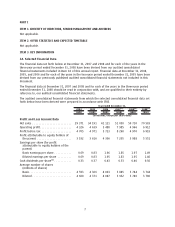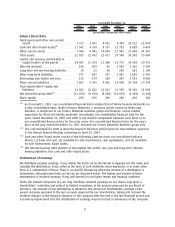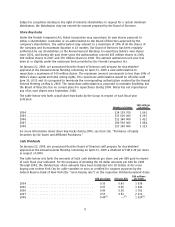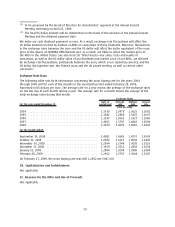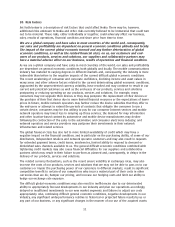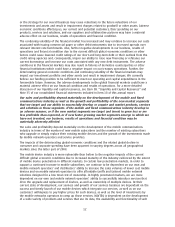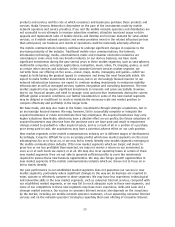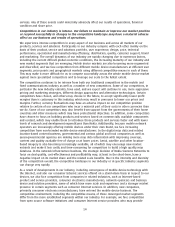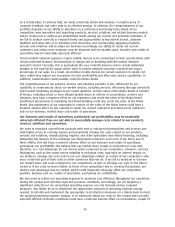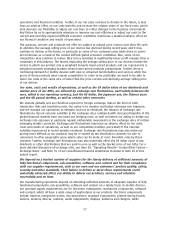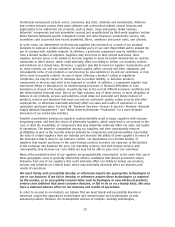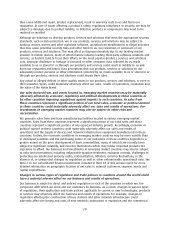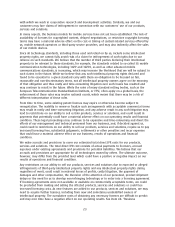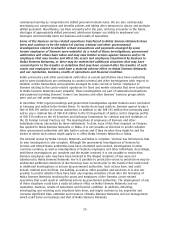Nokia 2008 Annual Report Download - page 18
Download and view the complete annual report
Please find page 18 of the 2008 Nokia annual report below. You can navigate through the pages in the report by either clicking on the pages listed below, or by using the keyword search tool below to find specific information within the annual report.operations and financial condition. Further, if our net sales continue to decline in the future, it may
have an adverse effect on our scale benefits and increase the relative share of our fixed costs, which
may decrease our flexibility to adjust our cost base to reflect changes in the business environment.
Any failure by us to appropriately maintain or improve our costefficiency or adjust our costs to the
current and currently expected difficult economic conditions could have a material adverse effect on
our financial condition and results of operations.
The products, services and solutions we offer are subject to natural price erosion over their life cycle.
In addition, the average selling price of our devices has declined during recent years and it may
continue to decline in the future, in particular as some of our customers may trade down to lower
priced devices as a result of the current difficult global economic conditions. Also, some of our
competitors may continue to reduce their prices resulting in significantly lower profit margins than is
customary in this industry. The factors impacting the average selling price of our devices include the
extent to which our product mix is weighted towards lowerpriced products and our regional mix is
weighted towards emerging markets where lowerpriced products predominate. Further, there is
continuing demand for mobile devices with new or enhanced functionalities and services while the
prices of those products must remain competitive. In order to be profitable, we need to be able to
lower our costs at the same rate or faster than the price erosion and declining average selling price
of our devices.
Our sales, costs and results of operations, as well as the US dollar value of our dividends and
market price of our ADSs, are affected by exchange rate fluctuations, particularly between the
euro, which is our reporting currency, and the US dollar, the Japanese yen, the Chinese yuan
and the UK pound sterling, as well as certain other currencies.
We operate globally and are therefore exposed to foreign exchange risks in the form of both
transaction risks and translation risks. Our policy is to monitor and hedge exchange rate exposure,
and we manage our operations to mitigate, but not to eliminate, the impacts of exchange rate
fluctuations. Recent extreme volatility in the exchange rates combined with decreased liquidity of the
global financial markets have increased our hedging costs, as well as limited our ability to hedge our
exchange rate exposure in particular against unfavorable movements in the exchange rates of certain
emerging market currencies. Exchange rate fluctuations may have an adverse affect on our sales,
costs and results of operations, as well as our competitive position, particularly if the extreme
volatility experienced in recent months continues. Exchange rate fluctuations may also make our
pricing more difficult as our products may be rerouted by the distribution channels for sale to
consumers in other geographic areas where sales can be made at more favorable rates by those
channels. Further, exchange rate fluctuations may also materially affect the US dollar value of any
dividends or other distributions that are paid in euro as well as the market price of our ADSs. For a
more detailed discussion of exchange risks, see Item 5A. “Operating Results—Certain Other Factors—
Exchange Rates” and Note 35 of our consolidated financial statements included in Item 18 of this
annual report.
We depend on a limited number of suppliers for the timely delivery of sufficient amounts of
fully functional components, subassemblies, software and content and for their compliance
with our supplier requirements, such as our own and our customers’ product quality, safety,
security and other standards. Their failure to deliver or meet those requirements could
materially adversely affect our ability to deliver our products, services and solutions
successfully and on time.
Our manufacturing operations depend on obtaining sufficient amounts of adequate supplies of fully
functional components, subassemblies, software and content on a timely basis. In mobile devices,
our principal supply requirements are for electronic components, mechanical components, software
and content, which all have a wide range of applications in our products. Electronic components
include chipsets, integrated circuits, microprocessors, standard components, printed wiring boards,
sensors, memory devices, cameras, audio components, displays, batteries and chargers, while
17


